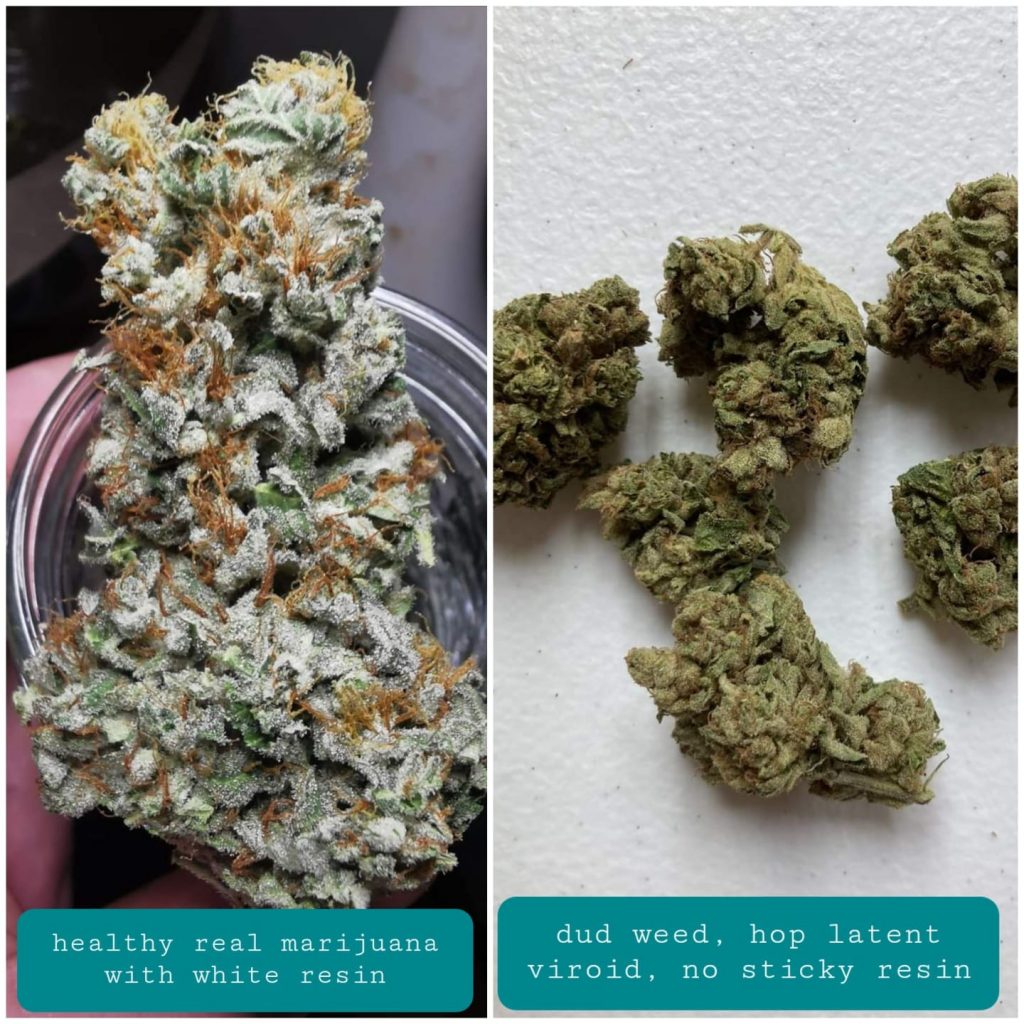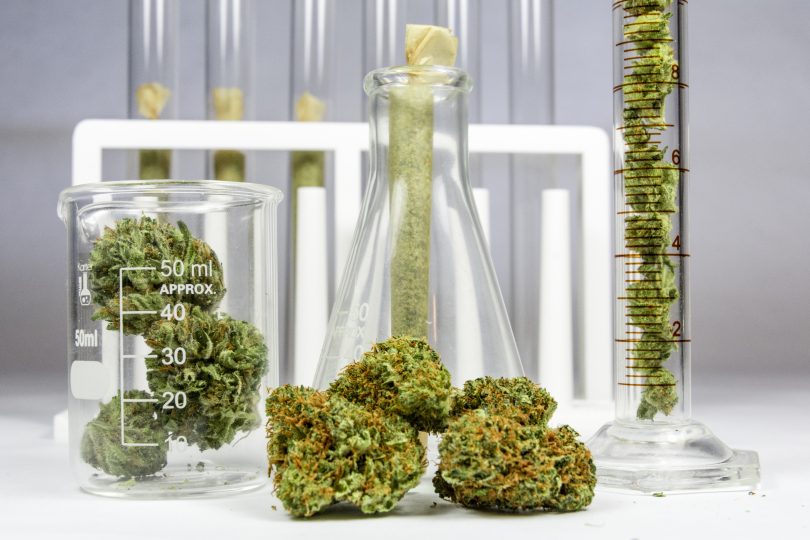When you go to a cannabis dispensary these days, there is an expectation that everything on the shelves is safe, legitimate, and exactly as advertised. In such tightly regulated markets, with all products requiring a certain level of testing before they can be sold to consumers, there is no reason to believe that you’re buying something other than what you think you’re buying.
Unfortunately, that’s not the case anymore. As Hop Latent Viroid (HpLVd) continues to infect crops at alarmingly rapid rates, it’s becoming quite common for growers and producers to pay extra money so labs will jack up the potency numbers or even lie about the detection of contaminants. So that weed you got from your favorite shop, the stuff you thought was clean with a label that stated something like 22.14% THC; could actually have closer to 14% percent cannabinoid content and be infected with mold, pesticides, and who knows what else.
Cannabis exciting and fun, yet very complex. From the extensive medical research going on behind the scenes, to studies on the plant’s biology, it seems that every day we’re learning something new about cannabis. For more articles like this one, make sure to subscribe to The THC Weekly Newsletter.
What is hop latent viroid?
First, let’s start with what a viroid is. Viroids are infectious, pathogenic, single-stranded circular ribonucleic acids (RNAs). Although they share a similar name, viroids and viruses are not the same and there are a few crucial differences between the two. First, viruses have a protein outer coating, whereas viroids do not. Also, viroids are smaller than viruses (they are the smallest infectious agents on earth) and they can only infect plants.
It’s generally believed that viroids do not pose any risk to human health, but they can be a substantial economic burden for farmers whose crops are infected. In total, it’s estimated that HpLVd is causing around $44 million dollars in annual losses; and that’s if it does not slip under the radar and go unnoticed. If every single plant that was impacted by this viroid was actually thrown out, those figures would be much higher.
Hop Latent Viroid (HpLVd) is not very well known among cannabis consumers, but it has affected numerous food and beverage crops for decades and it’s been a topic of growing importance in the pot industry, especially over the last few months. If left untreated, it can cause abnormal branching, poor trichome/resin production, lower potency, poor overall quality, and reduced yield. This is known as “dudding” or “dudding disease” in cannabis plants. HpLVd can also remain asymptomatic, or dormant, in some plants for many years.

During a largescale study of marijuana and hemp farms in the United States (mostly along the west coast and Canada), nearly every garden tested positive for this viroid in some capacity. Experts believe that up to 90 percent of crops in the largest US and Canadian markets are infected.
There are a couple different modes of introduction and transmission: mechanical spread from contaminated tools and equipment, insects like aphids or thrips, plant to plant transmission, or taking clones from infected mother plants. When it comes to HpLVd, education and prevention is key, rather than taking a wait-and-see approach and risk losing most of your plants.
According to Oscar Armando Dorantes, archaeologist and alumnus from San Diego State University who has been researching this phenomenon for almost two decades, “Crop disease in marijuana has gone unchecked for many years and the prevalence of these bad crops is rapidly becoming the norm. As early as 2004, I observed symptoms of hop latent viroid in California’s marijuana market. The dud marijuana has taken over the market and is accepted as normal now. Boomers and Gen X’ers know there is something different and wrong, but most of the younger crowd has only seen this diseased version.”
Lab testing in legal markets
Lab testing is the backbone of any legal cannabis market. All the products sold at licensed dispensaries are required to undergo testing from a “state-accredited facility” to confirm levels of cannabinoids and terpenes; as well as test for heavy metals, mycotoxins, residual pesticides, microbials, and any other unwanted contaminants.
Overall, the main purpose of lab testing is to guarantee compliance with whatever state protocols are in place to govern the sale of cannabis products. Every test requires certain procedures, different equipment, and needs to be performed by a licensed and trained specialist. Not only do these lab technicians need to be knowledgeable in their field, but they should be familiar with state and local testing regulations, as they are constantly changing.
Most labs are third party companies that are accredited through a state program. All labs have specific tests they are required to perform and guidelines they must abide to, but there are no universal standards in place.
Payoffs and padded results
I mentioned above that HpLVd affects trichome production and potency, and that up to 90 percent of some markets are infected… so how come most strains, even the bottom-shelf low-budget flowers, often test so high for THC levels?
“The best part of the harvest is submitted for testing and it’s only a sample of the harvest that gets evaluated during the testing process, it’s not the results of the actual cannabis in the container on the dispensary floor,” says Dorantes.
“Also, it’s been known that lab results are often padded in pay to play schemes of some labs offering better results for a higher price,” he added.
This might seem a bit shocking to some. I do believe a lot of people look at the cannabis industry through rose-colored glasses; as if those working in this sector all have your best interest in mind, or like the inudstry more close-knit than it actually is. But the reality is, when big money is on the line, you can expect something unscrupulous is going on behind the scenes.
When it comes to labs, it seems to be a dirty industry secret referred to as “lab shopping” – a shady practice in which growers and producers send their products to labs that have a reputation for inflating potency numbers and overlooking contaminants that would cause the product to fail purity tests at more reputable facilities.
Dylan Hirsch, executive vice president of Diagnostic Lab Corporation says that “Many of the labs will sometimes say they can get better results. It can be so subjective for results on THC.” Dr. Donald Land and Dr. Reggie Gaudino, two of the scientists in charge of running Berkeley’s Steep Hill Labs, one of the nation’s largest testing companies, echoed these statements. Both mentioned that their company is asked to boost potency number on a regular basis. “In almost every state we operate in we have someone approach us and say, ‘Hey, what would it take to get these numbers changed?’” Gaudino said.
The labs aren’t always to blame
It’s not always an issue of fraud, however. Guadino pointed out that Steep Hill Labs has spent millions of dollars on equipment and upgrades – a necessary financial burden for the ability to produce the most accurate results. But not all labs have the capital and many are cutting corners by using out of date equipment or questionable procedures to save money.
And sometimes, it’s not the fault of the lab at all. Some growers and manufacturers intentionally send in products different than the ones they plan on selling. They’ll send all their best, highest potency items in for testing then use the labels for other products. “There is no assurance that what the lab tested and what they are now selling to someone else is the same product,” mentioned Hirsch.
Basically, we have a whole system that’s functioning poorly and needs more oversight at multiple different levels. Some say there needs to more regulations and standardization, but there are plenty of laws and hoops that legitimate producers have to jump through already. The real issue here is implementation of these standards, a common problem in the industry already.
So, what happens next?
“The viroid f****d everything up,” Dorantes states bleakly. “I hypothesize it’s in many of the vape products too. From what I know, the best looking buds get sent for packaging and the low quality left over gets turned into concentrate. I have vaped disease-free product and it’s nothing like most of what you buy today.”
That being said, what happens next really depends on who you ask. For me personally, the next step is growing at home. It’s something I have been wanting to do for years and learning how widespread HpLVd is and how dishonest some of the testing facilities are, really solidified for me that now is the right time to start on that. I believe that in the coming years, as more people discover all the inconsistencies going behind the closed doors of the cannabis industry, the home cultivation sector, as well as DIY extraction, will likely explode.
It seems the only way to get anyone to take you seriously today’s world is by hitting them where it hurts, in the wallet. It’s not like HpLVd is some new, ambiguous problem with no known solutions. On the contrary, it’s been plaguing food farmers for ages and it’s relatively easy to control now through proper sanitation methods. The problem is getting rid of all the existing plants and clones that are infected and forcing growers to start over, as that could be devastating for their bottom line. But it’s really the only way.
Dorantes offers cultivators a few tips. “The problem is controlled and contained in the food industry because hop latent viroid affects our food farmers. The main thing to solve the problem is using purified water treated with chlorine dioxide like vegetables grower currently do, that’s known as integrated pest management, tool sanitation, and lab testing of mothers to rid of diseased plants.”
“A lot of people in the industry know about it, and it’s a dirty little secret,” he added.
Final thoughts on diseased crops and dishonest lab testing
Now that some of this unsavory information is making its way into the light, what do you, as a consumer, plan on doing? If you can’t trust the cannabis that is in circulation, or even the lab that’s supposed to be testing it for your safety, is the only logical solution to take matters into your own hands and grow your own bud? Let us know your thoughts in the comment section below.
Hello all! Welcome to CBDtesters.co, your ultimate online destination for the most relevant and thought-provoking cannabis and psychedelics-related news globally. Read-thru the site regularly to stay on top of the constantly-moving world of legal drugs and industrial hemp, and sign up for The THC Weekly Newsletter, Also save big on Delta 8, Delta 9 THC, Delta-10 THC, THCO, THCV, THCP & HHC products by checking out our “Best-of” lists!
Disclaimer: Hi, I’m a researcher and writer. All information in my articles is sourced and referenced, and all opinions stated are mine. I am not giving anyone advise, and though I am more than happy to discuss topics, should someone have a further question or concern, they should seek guidance from a relevant professional.









